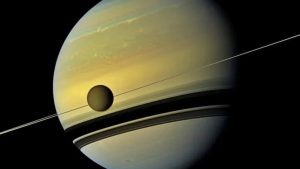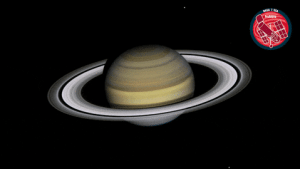Key Takeaways
- Scientists discovered polar and nonpolar substances can mix on Titan, defying classic chemistry rules
- Hydrogen cyanide and hydrocarbons form stable co-crystals at -180°C
- This discovery has implications for understanding prebiotic chemistry and life’s origins
Researchers from Chalmers University of Technology and NASA have made a discovery on Saturn’s moon Titan that challenges fundamental chemistry principles. At Titan’s extreme cold of -180°C, substances that normally don’t mix can combine to form new crystal structures.
Titan’s environment, with its thick nitrogen-methane atmosphere and landscape of lakes and dunes, closely resembles early Earth. This makes it ideal for studying chemical processes that could lead to life.
Breaking Chemistry Rules
The research focused on hydrogen cyanide (HCN) – abundant in Titan’s atmosphere – and its interactions with nonpolar hydrocarbons like methane and ethane. Contrary to the “like dissolves like” principle, these molecules mix to create co-crystals under Titan’s frigid conditions.
Through laboratory experiments and computer simulations, scientists showed hydrocarbons infiltrate hydrogen cyanide’s crystal lattice, forming stable new structures. The findings, published in PNAS, suggest these interactions influence Titan’s geology and surface features.
Implications for Life’s Building Blocks
Hydrogen cyanide is crucial as it’s a precursor to vital life molecules including amino acids and nucleobases. Understanding its chemistry in extreme environments expands our perspective on prebiotic chemistry – the chemical foundations before life emerged.
The collaboration began when NASA’s Jet Propulsion Laboratory approached Chalmers to interpret unexpected results from cryogenic experiments mixing hydrogen cyanide with methane and ethane.
Future Exploration
With NASA’s Dragonfly mission scheduled to reach Titan in 2034, these insights will guide future exploration. The discovery indicates that in cold cosmic environments beyond Earth, unconventional chemistry might create pathways for life’s building blocks, expanding our understanding of where and how life could originate in the universe.






